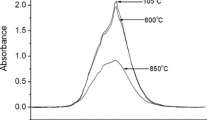Abstract
The thermal decomposition of a fibrous talc was studied by transmission electron microscopy (TEM) and selected-area electron diffraction (SAD). Small changes in the lengths of a and b unit-cell parameters were noticeable at 500°C, but the talc laths did not change morphologically until 800°C. At this temperature striations began to appear in the TEM image, and the talc SAD reflections began to develop faint satellite streaks. At 900°C the striations appeared to be crystallites, and reflections of orthorhombic enstatite were noted. Both TEM and SAD evidence showed that the enstatite crystallites were formed in three orientations corresponding to the three pseudohexagonal a axes of the talc. Thus, triple superposition of the electron diffraction pattern at the three equivalent angles explains the high symmetry star-shaped pattern. At 1000° to 1100°C the enstatite crystallites were shorter and thicker, and the streaks in the SAD pattern were nearly absent. Above 1200°C only one orientation of the enstatite crystallites was found. Noncrystalline regions were also detected at 900°C and became progressively scarce at 1000° and 1100°C. They were not detected at 1200°C. At 1300°C cristobalite was detected in some SAD patterns. The crystallographic axes and unit-cell parameters of the talc and enstatite were also topotactically related as follows: at (5.3 Å)//ce (5.2 Å); bt (9.16 Å)//be (8.8 Å); d(001)t (18.84 Å)//ae (18.2 Å). These results are compatible with an inhomogeneous decomposition mechanism as proposed by earlier workers.
Resumo
A decomposição térmica de um talco fibroso foi estudada por microscopia eletrônica de trans-missão (MET) e por difração eletrônica de área selecionada (SAD). Foram observadas ligeiras modificações nos comprimentos dos parâmetros da cela unitária aeba 500°C, mas as ripas de talco não apresentaram transformações morfológicas até 800°C, quando estriações começaram a aparecer nas micrografias e a desenvolver reflexões satélites em forma de traços muito tênues. A 900°C as estriações puderam ser caracterizadas corno cristalitos e começaram a aparecer reflexões de enstatita ortorrômbica. As evidências obtidas por MET e SAD mostraram que os cristalitos de enstatita foram formados em três orientações correspondentes aos três eixos a pseudohexagonais do talco; assim a tripla superposição do diagrama nos très ângulos equivalentes explica a alta simetria do diagrama em forma de estrela. Entre 1000° e 1100°C os cristalitos se tornaram mais curtos e mais grossos, e os traços no diagrama SAD quase desapareceram; acima de 1200°C apenas urna direção dos cristalitos de enstatita foi encontrada. Regiões não cristalinas foram detectadas a 900°C se tornando progressivamente mais raras entre 1000° e 1100°C e desaparecendo a 1200°C. A 1300°C pôde ser detectada a cristobalita em alguns diagramas de SAD. Os eixos cristalográficos e os parâmetros das celas unitárias do talco e da enstatita são relacionados corno se segue: at (5.3 Å)//ce (5.2 Å); bt (9.16 Å)//bt (8.8 Å); d(001)t (18.84 Å)//ae (18.2 Å). Os resultados do presente trabalho são compatíveis com um mecanismo de decomposição como aquele proposto por Taylor e por Brindley.
Similar content being viewed by others
References
Aumento, F. (1970) Serpentine mineralogy of ultrabasic in-trusives in Canada on the mid-Atlantic ridges: Can. Geol. Surv. Pap. 69-53, pp. 24, 46.
Ball, M. C. and Taylor, H. F. W. (1961) The dehydration of brucke: Mineral. Mag. 32, 754–765.
Ball, M. C. and Taylor, H. F. W. (1963) The dehydration of chrysotile in air and under hydrothermal conditions: Mineral. Mag. 33, 467–482.
Bapst, G. and Eberhart, J. P. (1970) Contribution à l’étude de la transformation talc-MgSiO3: Bull. Groupe Franç. Argiles 22, 17–23.
Brindley, G. W. (1961) The role of crystal structure in the dehydration reactions of some layer-type minerals. J. Min. Soc. Japan 5, 217–237.
Brindley, G. W. (1963a) Role of crystal structure in solid state reactions of clays and related minerals: in Proc. Int. Clay Conf., Stockholm, Vol. I, I. Th. Rosenquist and P. Graff-Petersen, eds., Pergamon Press, New York, 37–44.
Brindley, G. W. (1963b) Crystallographic aspects of some decomposition and recrystallization reactions: in Progress in Ceramic Science, Vol. 3, Pergamon Press, Oxford, 3–55.
Brindley, G. W. and Brown, G., eds. (1980) Crystal Structures of Clay Minerals and their X-Ray Identification: Mineralogical Society, London, p. 405.
Daw, J. D., Nicholson, P. S., and Embury, J. D. (1972) Inhomogeneous dehydroxylation of talc: J. Amer. Ceram. Soc. 55, 149–151.
Foster, W. R. (1951) High-temperature X-ray diffraction study of the polymorphism of MgSiO3: J. Amer. Ceram. Soc. 34, 255–259.
Kedesdy, H. (1943) Electron microscope study of calcination and steatite: Ber. Deutsch. Keram. Ges. 24, 201–233.
Mackenzie, R. C., ed. (1957) The Differential Thermal Investigation of Clays: Mineralogical Society, London, pp. 177, 180.
Nakahira, M. and Kato, T. (1964) Thermal transformation of pyrophyllite and talc as revealed by X-ray and electron diffraction studies: in Clays and Clay Minerals, Proc. 12th Natl. Conf., Atlanta, Georgia, 1963, W. F. Bradley, ed., Pergamon Press, New York, 21–27.
Rayner, J. A. and Brown, G. (1973) The crystal structure of talc: Clays & Clay Minerals 21, 103–114.
Taylor, H. F. W. (1962) Homogeneous and inhomogeneous mechanisms in the dehydroxylation of minerals: Clay Min. Bull. 5, 45–55.
Yada, K. and Kawakatsu, H. (1976) Magnetic objective lens with small bores: J. Electronmicros. (Japan) 25, 1–9.
Author information
Authors and Affiliations
Rights and permissions
About this article
Cite this article
de Souza Santos, H., Yada, K. Thermal Transformation of Talc as Studied by Electron-Optical Methods. Clays Clay Miner. 36, 289–296 (1988). https://doi.org/10.1346/CCMN.1988.0360401
Received:
Accepted:
Published:
Issue Date:
DOI: https://doi.org/10.1346/CCMN.1988.0360401




